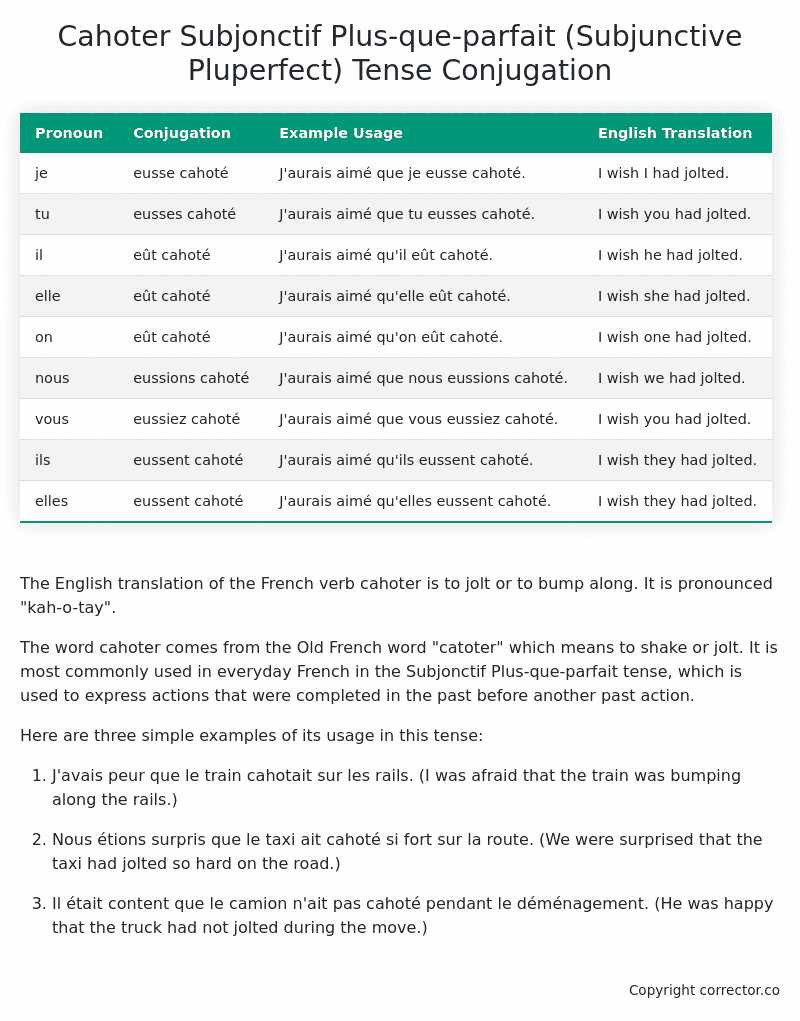Subjonctif Plus-que-parfait (Subjunctive Pluperfect) Tense Conjugation of the French Verb cahoter
Introduction to the verb cahoter
The English translation of the French verb cahoter is to jolt or to bump along. It is pronounced “kah-o-tay”.
The word cahoter comes from the Old French word “catoter” which means to shake or jolt. It is most commonly used in everyday French in the Subjonctif Plus-que-parfait tense, which is used to express actions that were completed in the past before another past action.
Here are three simple examples of its usage in this tense:
-
J’avais peur que le train cahotait sur les rails. (I was afraid that the train was bumping along the rails.)
-
Nous étions surpris que le taxi ait cahoté si fort sur la route. (We were surprised that the taxi had jolted so hard on the road.)
-
Il était content que le camion n’ait pas cahoté pendant le déménagement. (He was happy that the truck had not jolted during the move.)
Table of the Subjonctif Plus-que-parfait (Subjunctive Pluperfect) Tense Conjugation of cahoter
| Pronoun | Conjugation | Example Usage | English Translation |
|---|---|---|---|
| je | eusse cahoté | J’aurais aimé que je eusse cahoté. | I wish I had jolted. |
| tu | eusses cahoté | J’aurais aimé que tu eusses cahoté. | I wish you had jolted. |
| il | eût cahoté | J’aurais aimé qu’il eût cahoté. | I wish he had jolted. |
| elle | eût cahoté | J’aurais aimé qu’elle eût cahoté. | I wish she had jolted. |
| on | eût cahoté | J’aurais aimé qu’on eût cahoté. | I wish one had jolted. |
| nous | eussions cahoté | J’aurais aimé que nous eussions cahoté. | I wish we had jolted. |
| vous | eussiez cahoté | J’aurais aimé que vous eussiez cahoté. | I wish you had jolted. |
| ils | eussent cahoté | J’aurais aimé qu’ils eussent cahoté. | I wish they had jolted. |
| elles | eussent cahoté | J’aurais aimé qu’elles eussent cahoté. | I wish they had jolted. |
Other Conjugations for Cahoter.
Le Present (Present Tense) Conjugation of the French Verb cahoter
Imparfait (Imperfect) Tense Conjugation of the French Verb cahoter
Passé Simple (Simple Past) Tense Conjugation of the French Verb cahoter
Passé Composé (Present Perfect) Tense Conjugation of the French Verb cahoter
Futur Simple (Simple Future) Tense Conjugation of the French Verb cahoter
Futur Proche (Near Future) Tense Conjugation of the French Verb cahoter
Plus-que-parfait (Pluperfect) Tense Conjugation of the French Verb cahoter
Passé Antérieur (Past Anterior) Tense Conjugation of the French Verb cahoter
Futur Antérieur (Future Anterior) Tense Conjugation of the French Verb cahoter
Subjonctif Présent (Subjunctive Present) Tense Conjugation of the French Verb cahoter
Subjonctif Passé (Subjunctive Past) Tense Conjugation of the French Verb cahoter
Subjonctif Imparfait (Subjunctive Imperfect) Tense Conjugation of the French Verb cahoter
Subjonctif Plus-que-parfait (Subjunctive Pluperfect) Tense Conjugation of the French Verb cahoter
Conditionnel Présent (Conditional Present) Tense Conjugation of the French Verb cahoter
Conditionnel Passé (Conditional Past) Tense Conjugation of the French Verb cahoter
L’impératif Présent (Imperative Present) Tense Conjugation of the French Verb cahoter
L’infinitif Présent (Infinitive Present) Tense Conjugation of the French Verb cahoter
(this article)
Struggling with French verbs or the language in general? Why not use our free French Grammar Checker – no registration required!
Get a FREE Download Study Sheet of this Conjugation 🔥
Simply right click the image below, click “save image” and get your free reference for the cahoter Subjonctif Plus-que-parfait tense conjugation!

Cahoter – About the French Subjonctif Plus-que-parfait (Subjunctive Pluperfect) Tense
Formation
Common Everyday Usage Patterns
Hypothetical Situations
Reported Speech
Doubt, Wishes, and Emotions
Interactions with Other Tenses
Present Subjunctive
Imperfect Subjunctive
Conditional
Summary
I hope you enjoyed this article on the verb cahoter. Still in a learning mood? Check out another TOTALLY random French verb conjugation!


